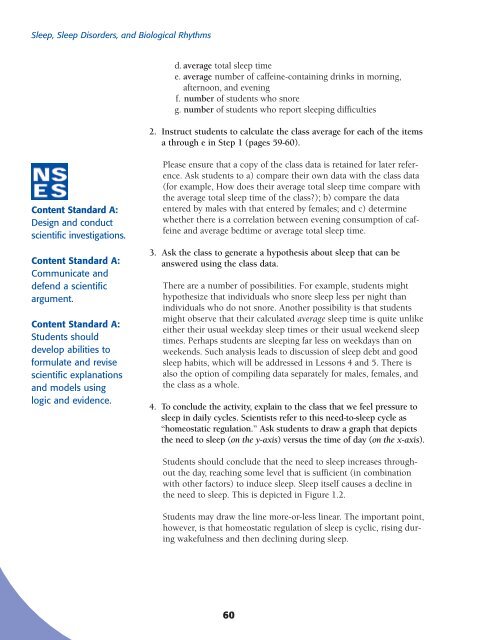Biological - NIH Office of Science Education - National Institutes of ...
Biological - NIH Office of Science Education - National Institutes of ...
Biological - NIH Office of Science Education - National Institutes of ...
Create successful ePaper yourself
Turn your PDF publications into a flip-book with our unique Google optimized e-Paper software.
Sleep, Sleep Disorders, and <strong>Biological</strong> Rhythms<br />
d. average total sleep time<br />
e. average number <strong>of</strong> caffeine-containing drinks in morning,<br />
afternoon, and evening<br />
f. number <strong>of</strong> students who snore<br />
g. number <strong>of</strong> students who report sleeping difficulties<br />
2. Instruct students to calculate the class average for each <strong>of</strong> the items<br />
a through e in Step 1 (pages 59-60).<br />
Content Standard A:<br />
Design and conduct<br />
scientific investigations.<br />
Content Standard A:<br />
Communicate and<br />
defend a scientific<br />
argument.<br />
Content Standard A:<br />
Students should<br />
develop abilities to<br />
formulate and revise<br />
scientific explanations<br />
and models using<br />
logic and evidence.<br />
Please ensure that a copy <strong>of</strong> the class data is retained for later reference.<br />
Ask students to a) compare their own data with the class data<br />
(for example, How does their average total sleep time compare with<br />
the average total sleep time <strong>of</strong> the class?); b) compare the data<br />
entered by males with that entered by females; and c) determine<br />
whether there is a correlation between evening consumption <strong>of</strong> caffeine<br />
and average bedtime or average total sleep time.<br />
3. Ask the class to generate a hypothesis about sleep that can be<br />
answered using the class data.<br />
There are a number <strong>of</strong> possibilities. For example, students might<br />
hypothesize that individuals who snore sleep less per night than<br />
individuals who do not snore. Another possibility is that students<br />
might observe that their calculated average sleep time is quite unlike<br />
either their usual weekday sleep times or their usual weekend sleep<br />
times. Perhaps students are sleeping far less on weekdays than on<br />
weekends. Such analysis leads to discussion <strong>of</strong> sleep debt and good<br />
sleep habits, which will be addressed in Lessons 4 and 5. There is<br />
also the option <strong>of</strong> compiling data separately for males, females, and<br />
the class as a whole.<br />
4. To conclude the activity, explain to the class that we feel pressure to<br />
sleep in daily cycles. Scientists refer to this need-to-sleep cycle as<br />
“homeostatic regulation.” Ask students to draw a graph that depicts<br />
the need to sleep (on the y-axis) versus the time <strong>of</strong> day (on the x-axis).<br />
Students should conclude that the need to sleep increases throughout<br />
the day, reaching some level that is sufficient (in combination<br />
with other factors) to induce sleep. Sleep itself causes a decline in<br />
the need to sleep. This is depicted in Figure 1.2.<br />
Students may draw the line more-or-less linear. The important point,<br />
however, is that homeostatic regulation <strong>of</strong> sleep is cyclic, rising during<br />
wakefulness and then declining during sleep.<br />
60

















